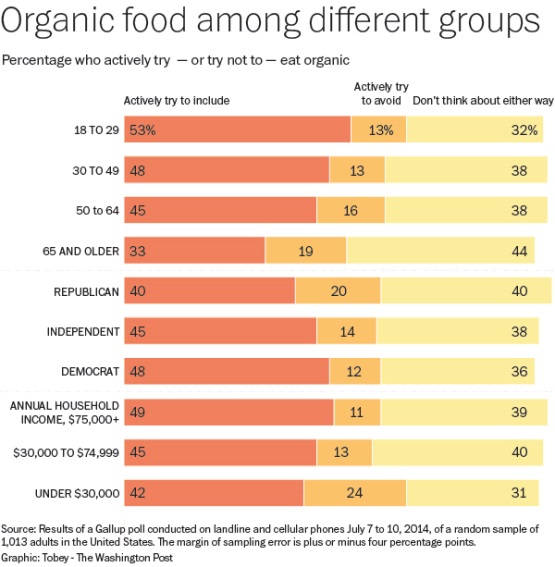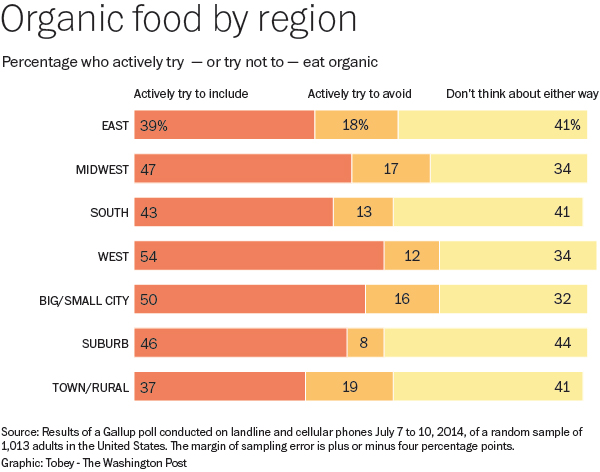20
Aug
Nearly Half of All U.S. Adults Seek Out Organic Food
(Beyond Pesticides, August 20, 2014) According to a new Gallup poll, nearly half of all U.S. adults “actively” seek to add organic food to their diets. Many who eat and incorporate organic foods into their diet are from city areas, whereas those who eat the least organic foods are described as coming from rural areas. Those who live in the western half of the country and are middle class were also more likely to eat organic food. The poll underscores the notion that many view the benefits of organic foods as greater than the perceived drawbacks, such as higher costs or limited access.
 The Gallup poll, as reported by The Washington Post, polled about 1,000 adults across the country in July and found that Americans most likely to eat organic are in the West, live in a city, are 18 to 29 years old, vote Democrat or have an annual household income greater than $75,000. Those most likely to avoid organic foods are basically the opposite: those who live in the East, live in more rural parts, are age 65 or older, vote Republican or have an annual household income less than $30,000. This is the first year Gallup has asked about eating organic foods in the annual Consumption Habits survey.
The Gallup poll, as reported by The Washington Post, polled about 1,000 adults across the country in July and found that Americans most likely to eat organic are in the West, live in a city, are 18 to 29 years old, vote Democrat or have an annual household income greater than $75,000. Those most likely to avoid organic foods are basically the opposite: those who live in the East, live in more rural parts, are age 65 or older, vote Republican or have an annual household income less than $30,000. This is the first year Gallup has asked about eating organic foods in the annual Consumption Habits survey.
Specifically, 45% of those polled actively try to include organic foods into their diet. The inclusion of organic foods is highest in the West (54%) and lowest in the East (39%). Americans who report living in a big or small city are more likely to eat organic foods than those who describe their location as a town or rural area, 50% versus 37%, respectively, while those who live in suburban areas fall between these two groups. While household income continues to be a factor in food choices, with almost half of upper-income Americans actively buying organic foods, a significant amount of lower-income Americans (42%) now include organic into their diets. The poll notes that “given that almost half of Americans actively try to include organic foods in their diets, they may view the benefits of organic foods as greater than their downsides, such as the higher cost or limited access.” While organic is associated with a “premium,” or more expensive cost, many say the cost of organic food simply reflects the true costs of production.
Overall, Gallup notes that income and location appear to be factors in preference for organic foods, although that may be changing. For instance, Wal-Mart, the largest retailer and grocer in the U.S., has announced plans to begin selling organic food, with the potential to make organic food more easily accessible and more affordable, which could in turn encourage more Americans to include it in their diets.
A similar 2014 poll by the Organic Trade Association (OTA) reports that consumption of organic products has continued to increase at a monumental pace. According to the survey, sales of organic products in the U.S. jumped to $35.1 billion in 2013, up 11.5% from the previous year’s $31.5 billion and the fastest growth rate in five years. The growth rate of organic food sales, which has averaged almost 10% every year since 2010, has dwarfed the average annual growth of just over 3% in total food sales during that same period, and now makes up 4 percent of the $760 annually spent on food. The fruit and vegetable category continues to lead the sector with $11.6 billion in sales, up 15%. With more than 10% of the fruits and vegetables sold in the U.S. now organic.
Organic food contributes to better health through reduced pesticide exposure for all and increased nutritional quality. An American Academy of Pediatrics’ (AAP) report on organic foods found that organic foods do provide health advantages by way of reducing exposure to pesticides, especially for children, even reporting “sound evidence” that organic foods contain more vitamin C and phosphorus. According to the report, “in terms of health advantages, organic diets have been convincingly demonstrated to expose consumers to fewer pesticides associated with human disease. Organic farming has been demonstrated to have less environmental impact than conventional approaches.” It also goes on to note that organic farming can be competitive and yields comparable to those of conventional farming techniques. AAP also recommends that “pediatricians should incorporate this evidence when discussing the health and environmental impact of organic foods and organic farming while continuing to encourage all patients and their families to attain optimal nutrition and dietary variety.” Another recent study reports that more nutritional antioxidants and far fewer toxic pesticides are found in organic foods
 In order to understand the importance of eating organic food from the perspective of toxic pesticide contamination, we need to look at the whole picture””from the farmworkers who do the valuable work of growing food, to the waterways from which we drink, the air we breathe, and the food we eat. The adoption of organic methods, particularly no-till organic, is an opportunity for farming both to mitigate agriculture’s contributions to climate change and to cope with the effects that change has on agriculture. Good organic practices can both reduce fossil fuel use and provide carbon sequestration in the soil through increased soil organic carbon. Higher organic soil carbon levels then increase fertility and the soil’s ability to endure extreme weather years.
In order to understand the importance of eating organic food from the perspective of toxic pesticide contamination, we need to look at the whole picture””from the farmworkers who do the valuable work of growing food, to the waterways from which we drink, the air we breathe, and the food we eat. The adoption of organic methods, particularly no-till organic, is an opportunity for farming both to mitigate agriculture’s contributions to climate change and to cope with the effects that change has on agriculture. Good organic practices can both reduce fossil fuel use and provide carbon sequestration in the soil through increased soil organic carbon. Higher organic soil carbon levels then increase fertility and the soil’s ability to endure extreme weather years.
Further, organic food can feed us and keep us healthy without producing the toxic effects of chemical agriculture. A growing organic sector is important as it creates healthier options for consumers, better working conditions for farmworkers, and a more sustainable environment. Additionally, organic agriculture prohibits the use of genetically engineered (GE) organisms, an issue many Americans are growing more concerned about. As organic continues to grow it is important to maintain our high organic standards to maintain consumer trust in the organic label.
It is important to protect the benefits that organic agriculture can provide by ensuring that organic standards are strong. However, there have been dramatic changes to the process that governs organic standards and the review of allowable materials in organic production, as overseen by the National Organic Standards Board (NOSB) under the Organic Foods Production Act, which undermines the integrity of organic. Consumer and environmental groups have voiced concerns that the new procedures create less rigorous review requirements, weakening the policies that have been in place for over 15 years and adopted by U.S. Department of Agriculture without any public input or consultation with the NOSB.
With more and more American eating organic it is important to take action to ensure a strong organic program and increase public trust in the organic food label. Visit Beyond Pesticides’ Save Our Organics page for information on what you can do to secure an organic future. To learn more about the environmental and worker benefits of organic production, see Beyond Pesticides’ Eating with a Conscience.
Source: The Washington Post










